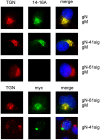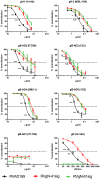Glycoprotein N of human cytomegalovirus protects the virus from neutralizing antibodies
- PMID: 23133379
- PMCID: PMC3486915
- DOI: 10.1371/journal.ppat.1002999
Glycoprotein N of human cytomegalovirus protects the virus from neutralizing antibodies
Abstract
Herpes viruses persist in the infected host and are transmitted between hosts in the presence of a fully functional humoral immune response, suggesting that they can evade neutralization by antiviral antibodies. Human cytomegalovirus (HCMV) encodes a number of polymorphic highly glycosylated virion glycoproteins (g), including the essential envelope glycoprotein, gN. We have tested the hypothesis that glycosylation of gN contributes to resistance of the virus to neutralizing antibodies. Recombinant viruses carrying deletions in serine/threonine rich sequences within the glycosylated surface domain of gN were constructed in the genetic background of HCMV strain AD169. The deletions had no influence on the formation of the gM/gN complex and in vitro replication of the respective viruses compared to the parent virus. The gN-truncated viruses were significantly more susceptible to neutralization by a gN-specific monoclonal antibody and in addition by a number of gB- and gH-specific monoclonal antibodies. Sera from individuals previously infected with HCMV also more efficiently neutralized gN-truncated viruses. Immunization of mice with viruses that expressed the truncated forms of gN resulted in significantly higher serum neutralizing antibody titers against the homologous strain that was accompanied by increased antibody titers against known neutralizing epitopes on gB and gH. Importantly, neutralization activity of sera from animals immunized with gN-truncated virus did not exhibit enhanced neutralizing activity against the parental wild type virus carrying the fully glycosylated wild type gN. Our results indicate that the extensive glycosylation of gN could represent a potentially important mechanism by which HCMV neutralization by a number of different antibody reactivities can be inhibited.
Conflict of interest statement
The authors have declared that no competing interests exist.
Figures








Similar articles
-
A Novel Strain-Specific Neutralizing Epitope on Glycoprotein H of Human Cytomegalovirus.J Virol. 2021 Aug 25;95(18):e0065721. doi: 10.1128/JVI.00657-21. Epub 2021 Aug 25. J Virol. 2021. PMID: 34160252 Free PMC article.
-
Glycoprotein N subtypes of human cytomegalovirus induce a strain-specific antibody response during natural infection.J Gen Virol. 2009 Aug;90(Pt 8):1951-1961. doi: 10.1099/vir.0.010967-0. Epub 2009 May 6. J Gen Virol. 2009. PMID: 19420160
-
Human cytomegalovirus infection elicits a glycoprotein M (gM)/gN-specific virus-neutralizing antibody response.J Virol. 2006 May;80(9):4591-600. doi: 10.1128/JVI.80.9.4591-4600.2006. J Virol. 2006. PMID: 16611919 Free PMC article.
-
Virion Glycoprotein-Mediated Immune Evasion by Human Cytomegalovirus: a Sticky Virus Makes a Slick Getaway.Microbiol Mol Biol Rev. 2016 Jun 15;80(3):663-77. doi: 10.1128/MMBR.00018-16. Print 2016 Sep. Microbiol Mol Biol Rev. 2016. PMID: 27307580 Free PMC article. Review.
-
Common Polymorphisms in the Glycoproteins of Human Cytomegalovirus and Associated Strain-Specific Immunity.Viruses. 2021 Jun 9;13(6):1106. doi: 10.3390/v13061106. Viruses. 2021. PMID: 34207868 Free PMC article. Review.
Cited by
-
Association of human cytomegalovirus (HCMV) neutralizing antibodies with antibodies to the HCMV glycoprotein complexes.Virol J. 2020 Aug 3;17(1):120. doi: 10.1186/s12985-020-01390-2. Virol J. 2020. PMID: 32746933 Free PMC article.
-
Human cytomegalovirus evades antibody-mediated immunity through endoplasmic reticulum-associated degradation of the FcRn receptor.Nat Commun. 2019 Jul 9;10(1):3020. doi: 10.1038/s41467-019-10865-y. Nat Commun. 2019. PMID: 31289263 Free PMC article.
-
Polymorphisms in Human Cytomegalovirus Glycoprotein O (gO) Exert Epistatic Influences on Cell-Free and Cell-to-Cell Spread and Antibody Neutralization on gH Epitopes.J Virol. 2020 Mar 31;94(8):e02051-19. doi: 10.1128/JVI.02051-19. Print 2020 Mar 31. J Virol. 2020. PMID: 31996433 Free PMC article.
-
Polymorphic Forms of Human Cytomegalovirus Glycoprotein O Protect against Neutralization of Fibroblast Entry by Antibodies Targeting Epitopes Defined by Glycoproteins H and L.Viruses. 2022 Jul 9;14(7):1508. doi: 10.3390/v14071508. Viruses. 2022. PMID: 35891489 Free PMC article.
-
Global Mapping of O-Glycosylation of Varicella Zoster Virus, Human Cytomegalovirus, and Epstein-Barr Virus.J Biol Chem. 2016 Jun 3;291(23):12014-28. doi: 10.1074/jbc.M116.721746. Epub 2016 Apr 15. J Biol Chem. 2016. PMID: 27129252 Free PMC article.
References
-
- Jackson SE, Mason GM, Wills MR (2011) Human cytomegalovirus immunity and immune evasion. Virus Res 157: 151–160. - PubMed
-
- Reddehase MJ (2002) Antigens and immunoevasins: opponents in cytomegalovirus immune surveillance. Nat Rev Immunol 2: 831–844. - PubMed
-
- Smith LM, Shellam GR, Redwood AJ (2006) Genes of murine cytomegalovirus exist as a number of distinct genotypes. Virology 352: 450–465. - PubMed
Publication types
MeSH terms
Substances
Grants and funding
LinkOut - more resources
Full Text Sources
Other Literature Sources

